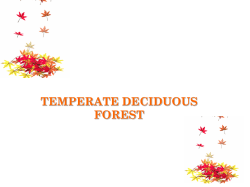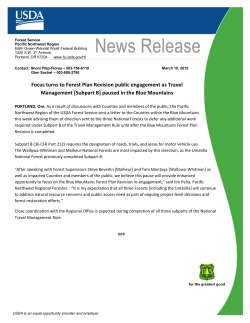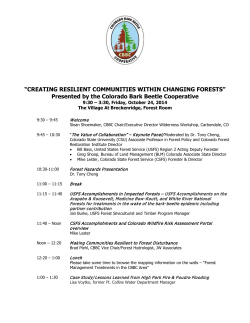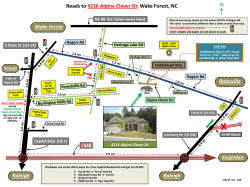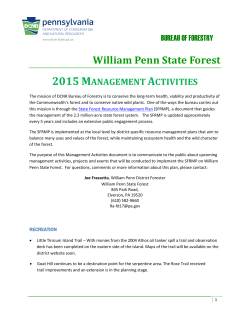
Living World - ARK Elvin Academy
Living World In this unit students learn about different ecosystems, where they are found and what they're like, and how they're used and managed. There are six key ideas in this unit. 1. An ecosystem is made up of plants and animals and the physical factors affecting them (climate and soil). These different parts interrelate and depend upon each other. There is a balance between the different parts. 2. Different ecosystems are found in different parts of the world due to the influence of climate and soils. The vegetation adapts to the climate and soils and is in harmony with it. 3. Temperate deciduous woodlands are used for a variety of reasons. They provide examples of successful, sustainable management. 4. Tropical rainforest is removed for a range of reasons. This has economic, social, political and environmental repercussions. 5. Tropical rainforest need to be managed sustainably. International co-operation is needed. 6. Hot deserts provide opportunities for economic development. 1. An ecosystem is made up of plants and animals and the physical factors affecting them (climate and soil). These different parts interrelate and depend upon each other. There is a balance between the different parts. What is an ecosystem? An ecosystem is a living community of plants (flora) and animals (fauna), which is linked to the natural environment where they live. Each element in the system depends upon and influences others. They are interrelated. There are often complex relationships between the living (biotic) and non-living (abiotic) components. Abiotic components include the climate (primarily temperature and rainfall), soil, water and light. Ecosystems can be identified at different scales. A local ecosystem can be a pond or a hedge. Larger ecosystems can be lakes or woodlands. It is also possible to identify ecosystems on a global scale, such as tropical rainforests or deciduous woodland. These global ecosystems are called biomes. How do ecosystems work? Every ecosystem works in the same way: Plants use sunlight, water and nutrients from the soil to produce their own food via photosynthesis and are called producers. Animals feed on plants (herbivores) or animals (carnivores) and are called consumers. Fungi and bacteria feed on dead and waste material and make things break down or rot. These are called decomposers and recycle nutrients for plants to use again. Without plants, all other living things would die. A food chain shows the different elements that live in an ecosystem, and what eats what to survive. A food web is more complex and shows all the different elements in a habitat and how they interrelate. The nutrient cycle shows how nutrients continually circulate within ecosystems. Changes to the ecosystem Different parts of an ecosystem depend on each other, and there's a fine balance between them. A change in one part of the ecosystem will affect other parts and upset the balance. Ecosystems around the world are facing changes including: climate change - which can affect where species can live, when they reproduce and the size of their populations habitat change - the conversion of land for farming can lead to a loss of habitat for huge numbers of species pollution - which, for example, can reduce oxygen levels in wetlands and rivers (killing fish), and also cause rapid plant and algae growth (called algae blooms) 2. Different ecosystems are found in different parts of the world due to the influence of climate and soils. The vegetation adapts to the cliate and soils and is in harmony with it. Global ecosystems are known as biomes. The dominant type of vegetation cover usually defines a biome. On a global scale, climate is the main factor which influences the distribution and characteristics of natural vegetation cover. This is because climate affects the growth conditions for vegetation: temperature - especially the seasonal pattern and length of the growing season. precipitation - particularly the total amount and how it's distributed throughout the year. hours of sunshine - which determines the amount of light available for photosynthesis. rates of evaporation, transpiration and humidity. Tropical rainforests are found close to the Equator. Hot desert ecosystems are closer to the Tropics of Cancer and Capricorn. The greatest extet is in the Sahara, where the African continent is widest. Deciduous forests are in temperate latitudes; they are located further north. They form the natural vegetation cover not only for the UK, but also over much of western and central Europe. What are these ecosystems like? You need to be able to describe the climate, soils and vegetation in each of the three biomes. You also need to be able to explain how the vegetation has adapted the climate and the soils. Temperature deciduous forest Tropical rainforest Hot desert Climate They are mainly found in Western Europe (including the UK) and the eastern parts of North America and Asia. The summers in these areas are warm and the winters cool. The annual temperature range in these areas is low, precipitation can occur throughout the year and there is a long growing season. The daily temperature is about 28C. It never goes below 20C and rarely above 35C. It is a very wet climate, at least 2000mm of rain falls a year. This makes the atmosphere very hot and humid. There are no real seasons. Each day's weather is the same - starting off hot and dry, with thunderstorms and heavy rain in early evening. The climate in the hot desert is characterised by high temperatures. Daytime temperatures can get up to over 40C but at night it can get very cold (below freezing) because there's no cloud to keep in the heat. There is a large daily temperature range. The hot desert is also very dry with less than 250mm of rainfall per year. There are two seasons - summer, when the sun is high in the sky and it's very hot, and winter when it is slightly cooler (although still very warm compared to the UK). Soils The most common type of soil is known as brown earth, which is reddish brown in colour. Deciduous trees lose their leaves every year. The fallen leaves slowly decompose which makes the soil fertile. Minerals are slowly washed (or leached) through the soil. The soils are red in colour and rich in iron. They have a thick layer of litter (dead leaves etc) but only a thin fertile layer because the leaves decompose very quickly in the humid conditions. The soils are not very good for plants to grow in as nutrients are quickly washed out of the soil because of heavy rainfall. Desert soils are rocky, sandy and grey in colour. They are extremely thin and can have a crust caused by the impact of infrequent heavy rainfall. Evaporation draws water up through the soil, leaving salts deposited near the surface. The soil is dry but can soak up water quickly when it rains. Vegetation Deciduous trees loose their leaves in the winter, when the light level and temperature falls. The vegetation in temperate deciduous forests grows in layers. The ground layer is dark and damp - ideal for plants like moss. Plants in the herb layer flower early, before the larger plants grow leaves and block out the light. The sub-canopy layer grows in the spaces between the taller trees, where there's more water when it rains and more light. Some roots are longer to reach different layers in the soil and reach moisture. The vegetation in rainforests grows in distinct layers and has adapted to the climate and poor soils. Trees are very tall and trunks are thin to reac sunlight. Buttress roots support these tall trees in shallow soils. Lianas are woody vines that climb high to reach the sunlight. Leaves in the tropical rainforest have drip tips to allow rainfall to drip down to the lower layers and shed heavy rainfall easily. The vegetation has adapted to survive in the harsh desert climate. Some plants store water in their roots, stems, leaves or fruits (these are known as succulents). Some plants have horiztonal root systems, just below the surface, to soak up water when it rains. SOme plants have long taproots (7-10m deep) to reach groundwater. Most plants have small leaves or spines and glossy/waxy leaves to reduce moisture loss. Seeds often stay dormant for years but can germinate quickly when it rains. Temperate deciduous forests - BBC Bitesize Tropical rainforests - BBC Bitesize Hot deserts - BBC Bitesize 3. Temperate deciduous woodlands are used for a variety of reasons. They provide examples of successful, sustainable management. For this section of the syllabus you need to know a case study of a temperate deciduous woodland, how it is used for timber and timber products, recreation and conservation. You also need to be able to explain ways in which the deciduous woodland is managed via controlled felling, replanting, planning for recreational use and conservation. Epping Forest, Essex Epping Forest is mostly ancient temperate deciduous woodland but it also includes areas of grassland and wetlands. The woodland mostly consists of beech trees but it also contains oak and hornbeam. The soils in the forest vary, depending on the rock below. The vegetation that grows on the surface depends on the soil below. Epping Forest is located northeast of London and covers an area of about 2,500ha and is about 19km long and 4km wide. It is the largest area of public open space near London. Epping Forest supports a variety of wildlife: the trees provide nesting sites for birds like tree creepers and nuthatches dead wood left to rot on the ground provides food for wood-boring beetles (including some rare and endangered species) the many bogs, pools and ponds provide homes for large numbers of wild fowl, aquatic plants and dragonflies grey squirrels, rabbits, muntjac deer and fallow deer also live there BBC Biteszie case study - Epping Forest How is Epping Forest being managed? Pollarding: this involves cutting off trees at about shoulder height to encourage new growth. Pollarding trees reshoot at this height, thereby providing new wood for future cutting (to provide firewood and wood for building). This is sustainable because it ensures a supply of wood for future generations. It also means that ancient trees have survived because instead of being felled for timber, they were pollarded. This type of management has been in place since Norman times and has ensured the survival of the forest. In 1878, as a response to local landowners attempting to buy parts of the forest, an Act of Parliament was passed which stated 'the Conservators shall at all times keep Epping Forest unenclosed and unbuilt on as an open space for the recreation and enjoyment of the people'. Since then the forest has been managed by the City of London Corporation. Site of Special Scientific Interest: over 1,600ha of the forest has been designated a SSSI. These are places which are important because of their plants and animals, or the geology and geography of the area and are subsequently protected. Areas of the forest have also been designated as an European Special Area of Conservation. These are areas which have been given protection by the EU. It involves increased protection for wild animals, plants and habitats and are an important part of global effort to conserve the world's species. Grazing: in the past commoners (people who lived in a forest parish and owned at least half an acre of land) had the right to graze their animals in Epping Forest. Grazing like this allows certain plant speices to thrive. In turn, many plant insects rely on those plants for their survival. Grazing continued into the 20th century but the number of cows decreased because of changing farming methods and the BSE scare. By 1996 there was no cows grazing on the land. In 2002 a small number of cattle were reintroduced to a small area of heathland in the forest. The herd has now grown to 50 cows. The City of London Corporation produces management plans to ensure that the forest continues to provide open space for the public while conserving the natural environment. Planning measures adopted include the following: managing recreation by providing appropriate car parks, toilets and refreshment facilities and by maintaining footpaths providing three easy-access parks to allow access for people with disabilities allowing old trees to die and collapse naturally unless they are dangerous controlling some forms of recreation, such as riding and mountain biking, which may damage or affect other forms of recreation preserving ancient trees by re-pollaridng them to enable new shoots to grow - since 1981, over 1000 ancient trees have been re-pollarded encouraging grazing to maintain the grassland and the flora and fauna associated with it preserving ancient earthworks and buildings maintaining ponds to prevent them silting up preserving the herd of fallow deer 4. Tropical rainforest is removed for a range of reasons. This has economic, social, political and environmental repercussions. Tropical rainforests are increasingly at threat from deforestation. Governments are viewing the rainforests as an untapped resource which can aid them in their quest for economic development. For this section of the syllabus you need to be able to explain the causes and impacts of deforestation with reference to the case study of Malaysia. Mayalsia's tropical rainforests Malaysia is a country in south-east Asia. It is made up of Peninsular (western) Malaysia and Eastern Malaysia. Along with neighbouring countries, the natural vegetation is tropical rainforest. nearly 63% of Malaysia is forested and commericla tree crops, primarily rubber and oil palm, occupy a further 13%. Trees and forest cover an area equivalent to the whole of the UK. In the past most of the country was covered in primary (virgin - unaffected by the actions of people) rainforest. In Peninsula Mayalsia most of this has now gone and little is left on Borneo. Today an estimated 18% of Malaysia's forest is virgin forest. Malaysian rainforests support over 5500 species of flowering plants, 2600 species of tree and 1000 species of butterflies. Of the 203 species of mammals, 78% live only in forests. The rate of deforestation in Malaysia is increasing faster than in any other tropical country in the world, increasing 85% between 1990-2000 and 2000-2005. Since 2000, some 140,200ha of forest have been lost on average each year. Social Economic Positive impacts Negative impacts Poor urban dwellers have had the opportunity to set up businesses and improve their quality of life. Indigenous tribes forced to move Better transportation links Large scale farming provides food Area has become economically profitable and has contributed to Malaysia's GNP Profits can be used to improve Malaysia's infratstructure and level of development Environmental Political Malaysia is now a more influential exporter on a global scale Profits from the businesses in the area rarely go to local people Thousands of hectares of rainforest have been destroyed Amount of virgin rainforest cover has decreased dramatically Loss of habitats Survival of species, including the orang-utan, is threatened 5. Tropical rainforest need to be managed sustainably. International co-operation is needed. In order to manage the rainforest sustainably a variety of management techniques have been used in Malaysia. Make sure you can explain each of these strategies with specific detail on why it is or isn't sustainable. National Forest Policy Widespread logging in Malaysia started after the Second World War due to improvements in technology (e.g. chainsaws, trucks etc). The government responded by passing the National Forestry Act in 1977. The Act paved the way for sustainable management of Malaysia's rainforests and had the following aims: develop timber processing to increase the profitability of the exported wood and reduce demand for raw timber. THe export of low-value raw logs is now banned in most of Malaysia. encourage alternative timber sources (e.g. from rubber trees) increase public awareness of the forests increase research into forestry involve local communities in forest projects One of the main initiatives of the 1977 Act was to introduce a new approach to forest management known as Selective Management System. This is recognised as one of the most sustainable approaches to tropical forestry management in the world. Stage Actions 2 years before felling Pre-felling sutdy to identify what is there 1 year before felling Commercially viable trees marked for felling. Arrows painted on trees to indicate direction of felling to avoid damaging other valuable trees Felling Felling carried out by licence holders 3-6 months after felling Survey to check what had been felled Prosecution may result from illegal felling 2 years after felling Treatment plan drawn up to restore forest 5-10 years after felling Remedial and regeneration work carried out by state forestry officials. Replacement trees planted. 30-40 years after felling Cycle begins again. But, a lack of trained officials to enforce and monitor the system across the country has led to the continuation of abuses and illegal activities. Remedial measures, such as replanting, have not always been carried out satisfactorily. Deforestation is still taking place in Borneo where land is being converted into oil palm plantations. Permanent Forest Estates and National Parks The government to identify Permanent Forest Estates. These are areas which are protected with no development or conversion of land use allowed. Large areas of forest however, are used for commercial logging. Some 10% of the forested land (mainly primary forest areas) have special conservation status ensuring the survival of the rainforest habitats and species. Forest Stewardship Council The Forest Stewardship Council (FSC) is an international organisation that promotes sustainable forestry. Products that have been sourved from sustainably manged forests carry the FSC label. The FSC aims to educate manufacturers and consumers about the need to buy wood from sustainable sources. It also aims to reduce demand for rare and valuable tropical hardwoods. Developing Tourism Malaysia has promoted its forests as destinations for ecotourism. This aims to introduce people to the natural world without cauisng any environmental damage. The great benefit of ecotourism is that it enables the undisturbed natural environment to create a source of income for local people without it being damaged or destroyed. Worldwide Initiatives Rainforests are valuable resources which poor countries want to use to expand their economies and increase their level of development. As well as timber rainforests occupy land that could be used for commercial agriculture such as plantations or ranching. Valuable mineral resources such as bauxite, copper or iron may be present in the rock below the forests. To expect countries not use these resources available to them is naive, even though they are important at a global scale. To encourage poorer countries to not develop their rainforest areas various strategies have been used globally. Debt relief: rainforests are recognised globally and attributed a monetary value. Countries are paid to maintain the rainforests, this could take the form of debt relief (countries are relieved of some of their debt in return for protecting their rainforests) Carbon sinks: in recocognition of rainforest's role in reducing global warming money is given to support rainforest areas as a way of reducing carbon dioxide levels globally e.g. Gola Forest, Sierra Leone is supported by the European Commission, the French Government and the RSPB. 6. Hot deserts provide opportunities for economic development. For this part of the syllabus you need to know a case study of a hot desert from a richer part of the world and from a poorer part of the world. You need to know how these areas provide economic opportunities and the management of each area to ensure their challeneges are met and sustainability is ensured. The Australian Outback Managing the challenges Farming - farming in the outback is very challenging because of the lack of water. Farmers there have two main water sources: most farms have dams and resevoirs to store water for sheep and cattle the farmers also use boreholes to tap into underground water supplies. Although farmers can currently meet the challenges of the harsh environment, recent droughts in Australia have put pressure on the land and water supplies. This has led people to question whether both water and land are being used sustainably. Tourism - the new Uluru Aboriginal Cultural Centre educates people about aboriginal culture and history. Aboriginal guides also lead outback walks to inform visitors about bush food, as well as the significance of Uluru as a sacred site and other cultural subjects. The new Cultural Centre provides economic as well as cultural benefits. The income from the admission fees goes to the Anangu community. Today over 30 aboriginal people work in the park, and the park's management is dominated by aboriginal owners. The Sahara Desert Energy There are believed to be large oil and gas reserves underneath the Sahara Desert however, they are difficult to find and extract. For Algeria, though, oil and gas are an important source of income for the country (half its total income). Drilling for oil at the Hassi Messaoud oilfield isn't easy as: it's difficult to get there, the oilfield is deep in the desert so the workers have to travel in and out by plane. 40,000 people work at Hassi Messaoud. They have to pump their water supplies from underground aquifers and fly in their food they have to drill hundreds of metres down to reach the oil and gas supplies pipelines have to carry the oil for hundreds of kilometers across the Sahara to ports on the North African coast Using fossil fuels like oil and gas is not sustainable so Algeria is beginning to prepare for a future without them. Work has begun on constructing the country's first solar power plant. They aim to cover large areas of the desert with solar panels to then export the solar power to Eueope through cables below the Mediterranean Sea. Farming and irrigation Egypt is hot and dry. It also has a soaring population (increased from 20 million to 79 million in the last 25 years) and is expected to continue growing rapidly. Most Egyptians live in the heavily irrigated Nile Valley. The irrigated land means that farmers can grown food, both to feed Egypt's growing population and for export (13% of Egypt's GDP comes from agriculture and employs 32% of the labour force). However, Egypt's irrigated land is increasingly suffering from salinity. Irrigation water contains mineral salts. When the water evaporates from the surface of the soil, the salt crystals are left behind. Most plants then die, and the land that irrgiation was meant to improve is destroyed. Because Egypt's farmland is increasingly being lost to urbanisation, wind-blown sand and salinity, the Eygptian government has begun a scheme to irrigate more land away from the Nile Valley. The Toshka Project will cost $70 billion and will use pumps and canals to transfer water from Lake Nasser into the Western Desert. It aims to: increase Egypt's irrigated land area by 30% enable high-value crops, such as olives, citrus fruits and vegetables to be grown provide food, electricity and jobs for 16 million Egyptians in new towns in the desert improve roads, railways and telecommunications promote tourism Farming and desertification The Sahel is a belt of land south of the Sahara. It is under intense pressure and in some places the quality of the land has declined so much that it's turned into desert. This process is called desertification. The main causes are: climate - the Sahel is getting drier overgrazing - cattle, sheeps and goats are overgrazing the vegetation leaving the soil exposed to wind erosion population growth - this is increasing demand for food and the resulting overcultivation of crops is using up the nutrients in the soil so eventually nothing will grow demand for fuel wood - this is also increasing so the land is being cleared of trees that bind the soil together and prevent soil erosion There are ways in which desertication can be stopped and even reversed. The following strategies have been successfully implemented in the Sahel: Reducing the number of farm This stops overgrazing and allows the protective vegetation to grow back. animals Growing crops as well as keeping animals The animal manure is used to fertilise the soil and help the crops to grow Planting more trees This protects the soil from wind and rain. The tree roots help to hold the soil together and prevent erosion Building earth dams These collect and store water in the wet season. The stored water is then used to irrigate crops in the dry season.
© Copyright 2025
